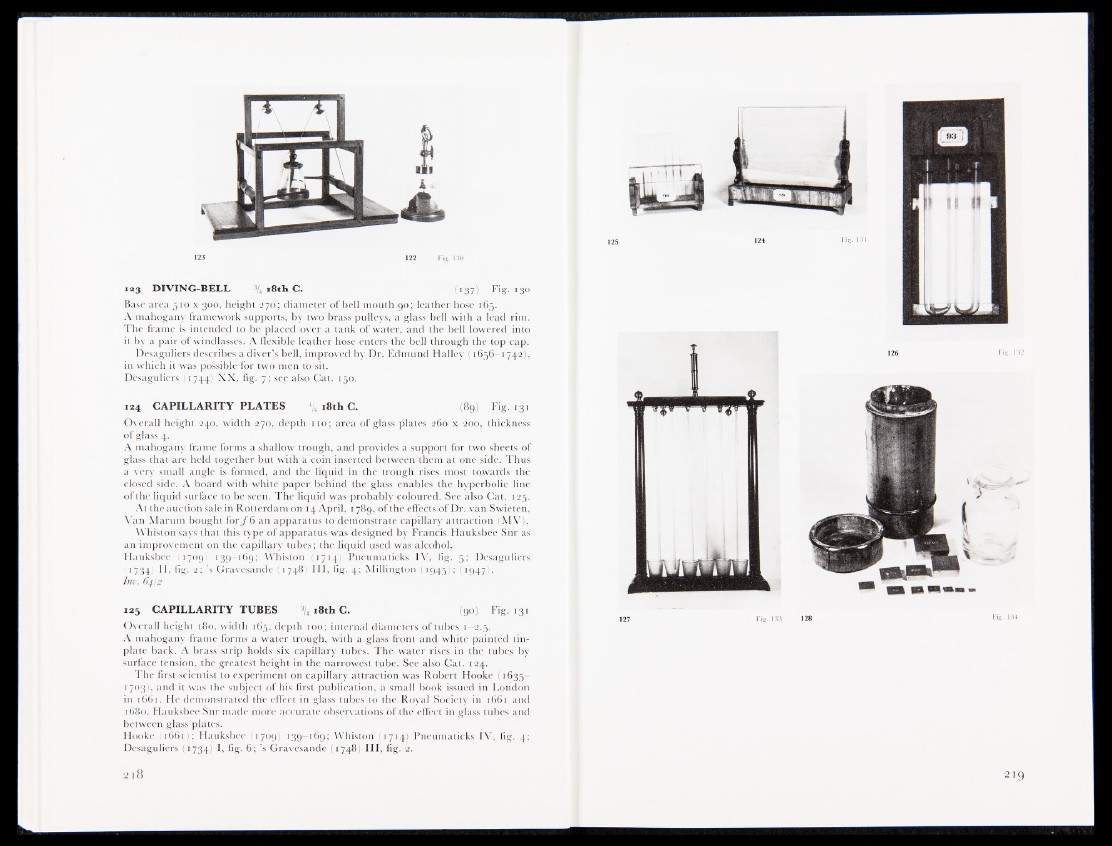
123 DIVING-BELL 3/4 18th C. (I37)5 Fig- 130
Base area 510 x 300, height 270; diameter of bell mouth 90; leather hose 165.
A mahogany framework supports, by two brass pulleys, a glass bell with a lead rim.
The frame is intended to be placed over a tank of water, and the bell lowered into
it by a pair of windlasses. A flexible leather hose enters the bell through the top cap.
Desaguliers describes a diver’s bell, improved by Dr. Edmund Halley (1656—1742),
in which it was possible for two men to sit.
Desaguliers (1744) XX, fig. 7; see also Cat. 150.
124 CAPILLARITY PLATES 4/4 18th C. (89) Fig. 131
Overall height 240, width 270, depth 110; area of glass plates 260 x 200, thickness
of glass 4.
A mahogany frame forms a shallow trough, and provides a support SpPtwo sheets of
glass that are held together but with a coin inserted between them at one side. Thus
a very small angle is formed, and the liquid in the trough rises most towards the
closed side. A board with white paper behind the glass enables the hyperbolic line
of the liquid surface to be seen. The liquid was probably coloured. See also flat. 125.
At the auction sale in Rotterdam on 14 April, 1789, of the effects of Dr. van Swieten,
Van Marum bought for f 6 an apparatus to demonstrate capillary attraction (M V B
Whiston says that this type of apparatus was designed by Francis Hauksbee Snr as
an improvement on the capillary tubes; the liquid used was alcohol.
Hauksbee (1709) 139—169; Whiston (1714) Pneumaticks IV, fig. 5; Desaguliers
1734) II, fig. 2; ’s Gravesande (1748) III, fig. 4; Millington (1945); (1947^^!
Inv. 64/2
125 CAPILLARITY TUBES 3/4 18th C. (gof( Fig, 131
Overall height 180, width 165, depth 100; internal diameters of tubes 1-2,5.
A mahogany frame forms a water trough, with a glass front and white painted tinplate
back. A brass strip holds six capillary tubes. The water rises in the tubes by
surface tension, the greatest height in the narrowest tube. See also Cat. 124.
The first scientist to experiment on capillary attraction was Robert Hooke (1635—
1703), and it was the subject of his first publication, a small book issued in London
in 1661. He demonstrated the effect in glass tubes to the Royal Society in 1661 and
1680. Hauksbee Snr made more accurate observations of the effect in glass tubes and
between glass plates.
Hooke (1661); Hauksbee (1709) 139—169; Whiston (1714) Pneumaticks IV, fig. 4;
Desaguliers (1734) I, fig. 6; ’s Gravesande (1748) III, fig. 2.
0 i'S '